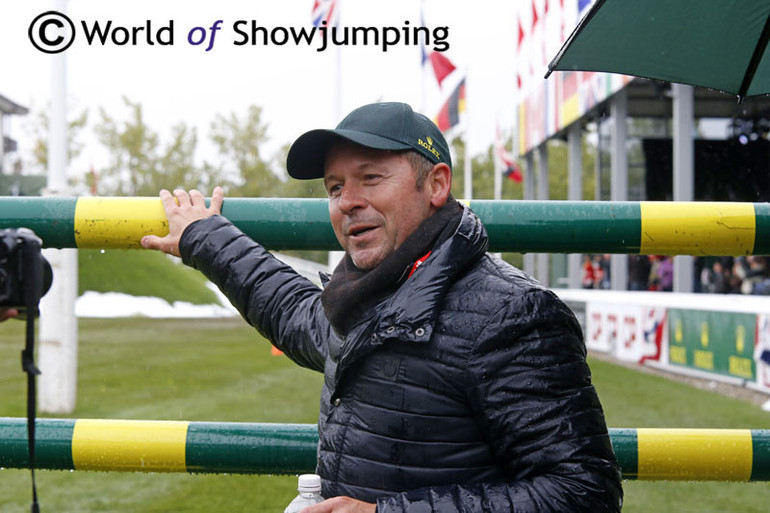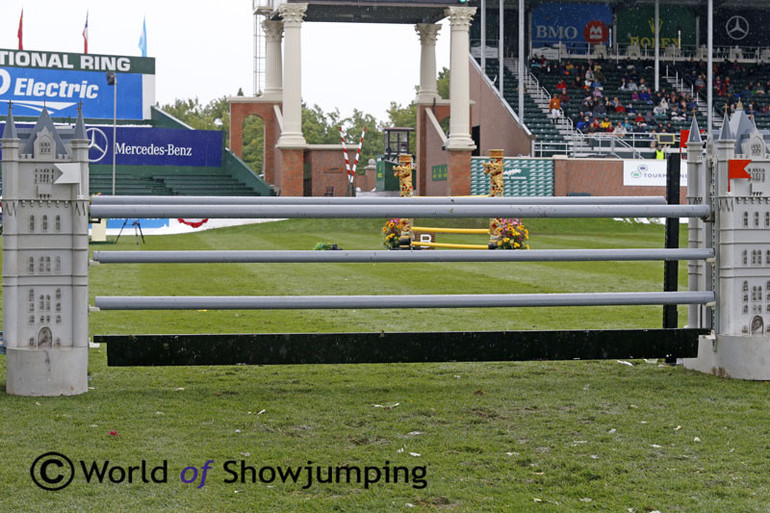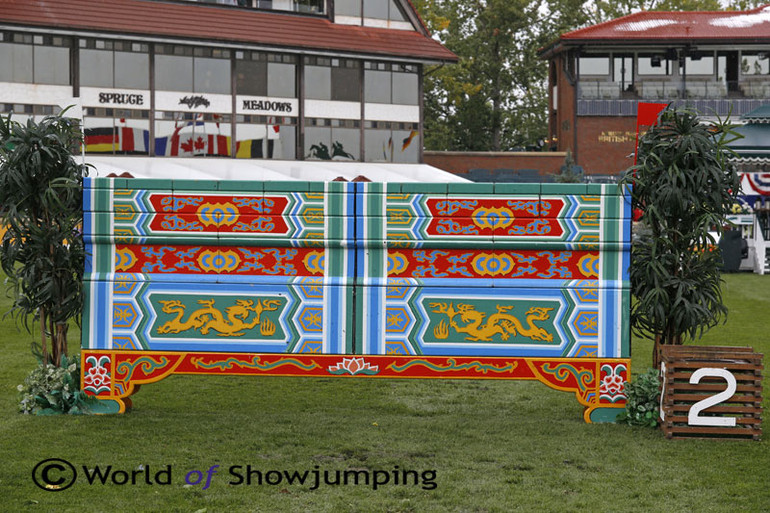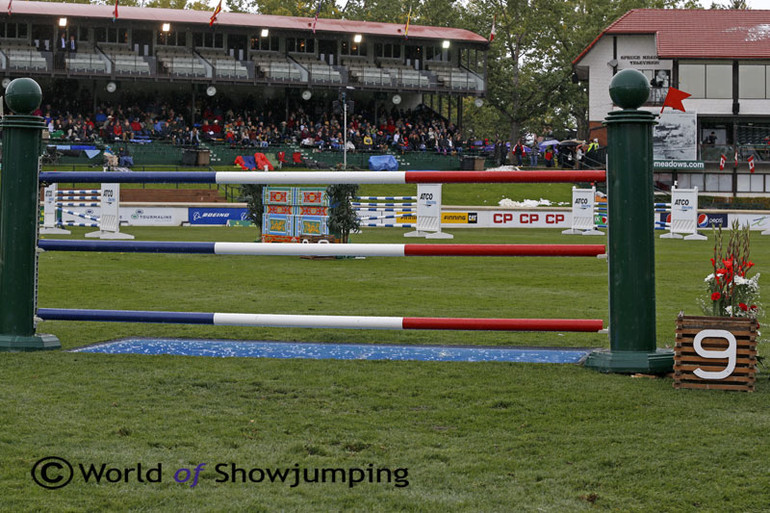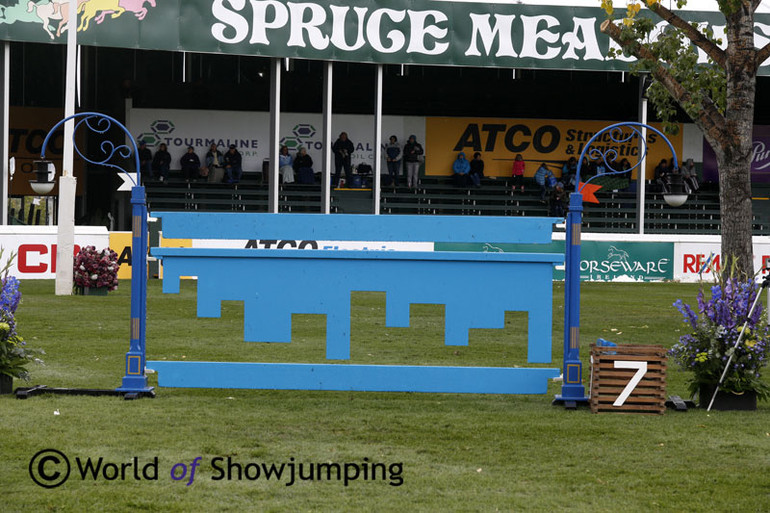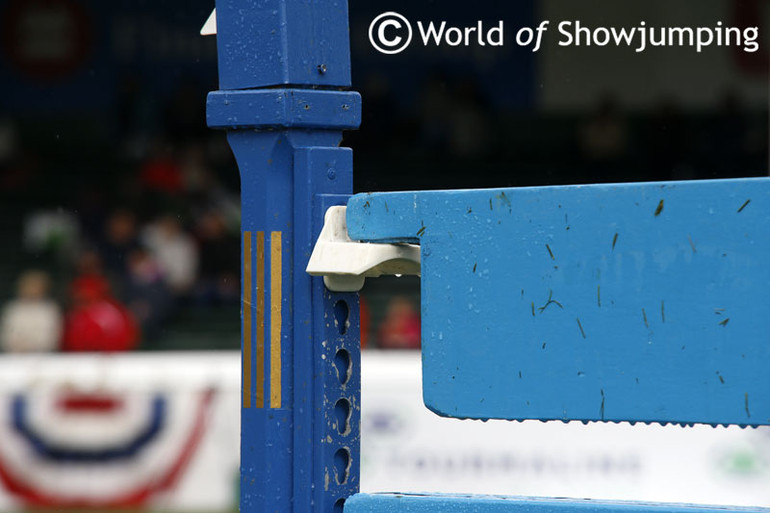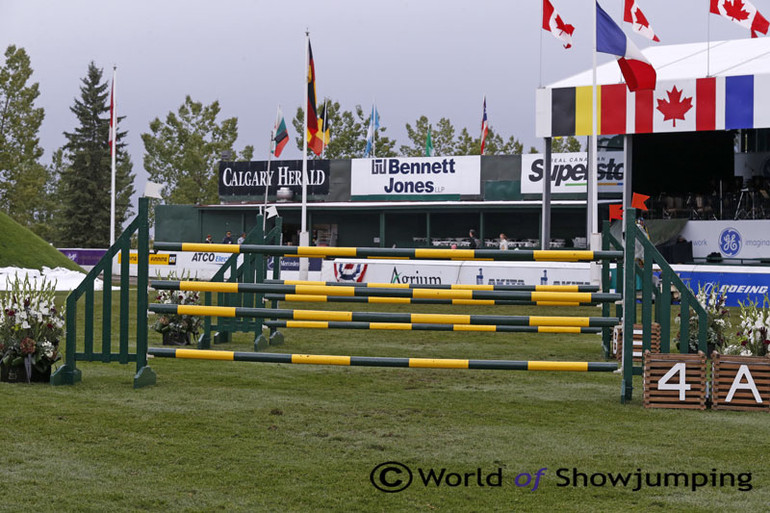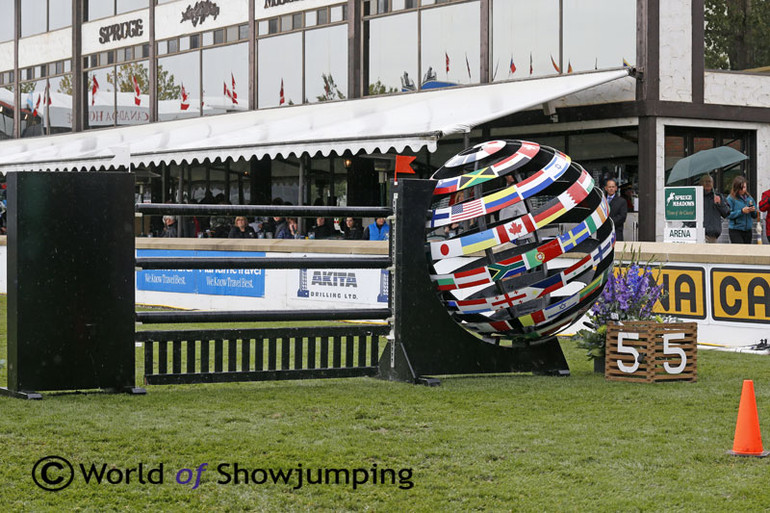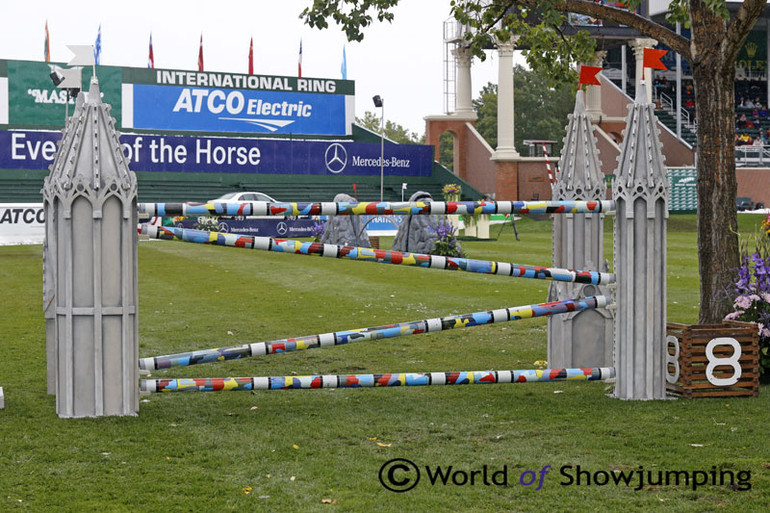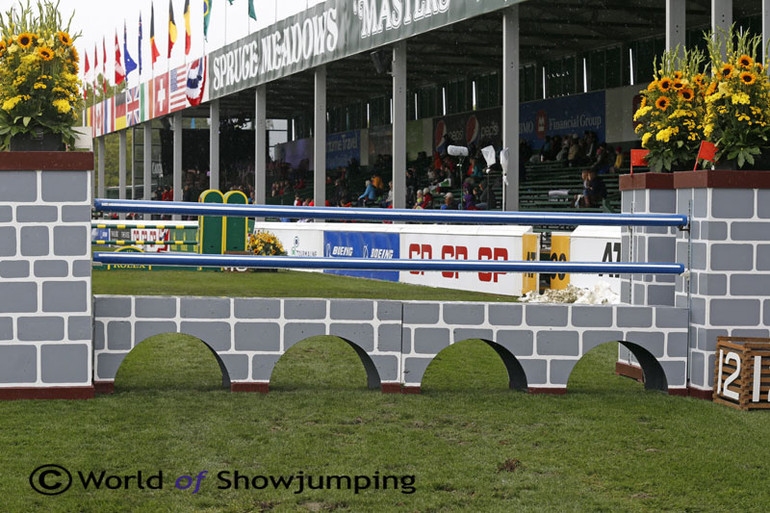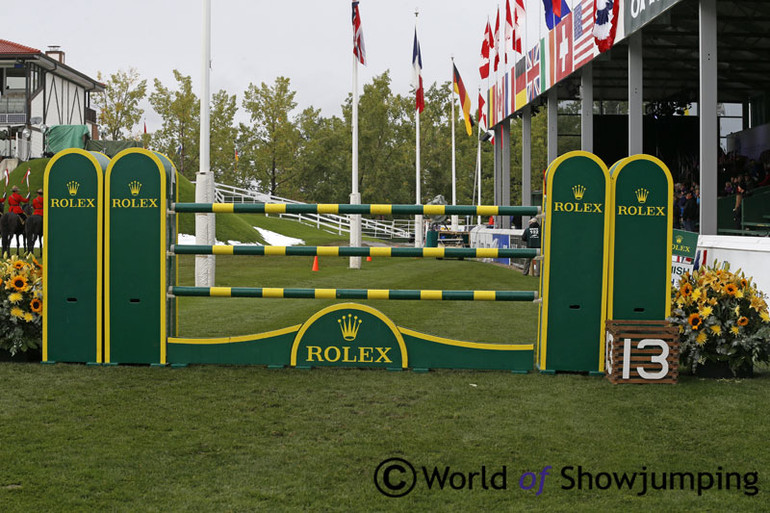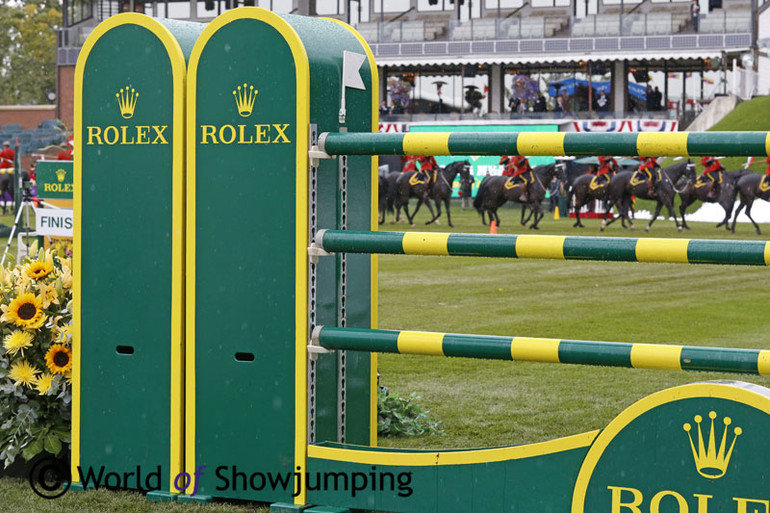Rolex organized a very educational course walk during the Masters tournament at Spruce Meadows - this time is was not about in which order the fences should be jumped or the distances in between. Instead Eric talked about why some fences are more difficult to jump just from the way they look. Get to learn all about it in this photo series! All photos (c) Jenny Abrahamsson.
"The course designer Leopoldo plays around with the colors. If you look at the black in the bottom it will distract the horse's eye to the ground. It is an oxer, but he kept it a narrow oxer which make the back pole a little bit hidden. The difficulties with that is that the horses might think it is a vertical and not an oxer. The horse will get there and think it is a vertical and get a little surprised of the back pole. So the first fence isn't a difficult fence, but the horses can misjudge the fence as it is narrow, with the black on the bottom and grey is not a color that horses respect a lot. They attend to be a little casual about the grey. The color of the fences also add a lot of difficulties to them, yellow for example is a very difficult color to jump as is white and black."
"Years ago a wall used to be a free fence, because they were very solid in construction. This wall looks solid, but these blocks on top are very light and if you watched the Olympics in Beijing this wall came down quite a few times. And still today this wall comes down. The difficulty with this fence is that it is in the middle of nowhere and there are no wings attached to it. So you have to guide the horse to the center and hope that the horse doesn't think right or left because there is nothing to guide it other than the green plants. So for a horse it is difficult to focus and recognize this as a fence. The other hard thing for a horse is that it doesn't see the other side. With other fences they can see what's on the other side, even if there are a lot of poles, but with a wall they don't know. As I said, years ago we said it is a free fence, this is now a careful fence and it ends up having a lot of faults. It is called a vertical since it is upright, but you have to ride to it a bit more like an oxer since the horses will fall back a little bit for the reason that they can't see the other side."
"This is called a liverpool. The difficulties with this fence is that the water is set forward. With a liverpool you can set the water in the middle - which is the easiest way for a rider to jump it - or put it in the back, which is also easier for a rider because that gives you a ground line. But this time Leopoldo sets it forward which is the most difficult way to jump a liverpool vertical, and the reason behind that is that you need to get the horse a little bit close to it because the water obstacle is something that a horse can spook on, and sometimes back up - but at the same time the horse will try to arc itself to clear the back of it. For a horse they always learn to stretch forward and jump long over a water jump, and that is why they often jump a fence like this a little bit too far. So many rails will come from behind on a jump like this. Not so many with the front legs, but back hand rails since the horses are continuing a little bit too long with the arc and will get a little tense behind."
"The Sydney plank is also a very delicate fence to jump. This is the only fence in the course where Leopoldo reverses the cups. It has no holding what so ever. So this fence doesn't tolerate any sort of touch what so ever. It is a very careful fence, and the horses spook at it since they look through it. It is filled up at the top and then you have the holes at the bottom, so they will look and get a little bit tight off the ground and tend to hold themselves a bit. This is the most careful fence today. It is on a distance with a short five strides today which helps you, but I have seen Leopoldo set this fence after long strides so then you have to keep going and that makes it very difficult to jump. Today it is presented in a nice way."
The reversed cups as described above.
"Here we come to the double. It is not the color and it is nothing with this double that is difficult, it is where it is situated. It is in the end of the ring by itself where the horses are galloping away from where they want to be, which is the ingate, so they are leaving all their buddies behind. So now they have to go down the line with the band in behind and everything else. So the difficulties with this is to guide them and say it is ok and stay with me."
"Leopoldo loves to use skinny fences. It does come down a lot. Since the poles are short they are much lighter and not as heavy as the long poles. Whenever a fence gets difficult the horses tend to tighten themselves off the ground and sort of hold their breath as we call it. And then they often don't reach the height of the fence. When we riders turn the corner to a skinny fence we kind of hold the breath ourselves. It is not a lot we can do about it to be honest. We give the horses the proper distance, we try to be as far away as we can to leave the room to jump the fence. You don't want to get close to this fence. Obviously Leopoldo used this decoration here that is so close to the horses, so the horses leave the ground and will move left. Black is normally difficult to jump, but on a skinny fence black is my favorite color. I don't really have an answer why, the horses tend to jump black a little bit better on a skinny fence than other colors."
"This fence is from the World Championships in Normandy and just arrived this morning. It is a beautiful fence and the horses jump it well. I find this an easy fence to jump because it is a little bit spooky and the horses respect it. They see all these colors and you can ride to this fence."
"This is the most difficult fence on this course today - to jump. Here you have the wall at the bottom which is a distraction. It is just like the first fence, the horses will peek down. And these poles are difficult for us as riders to see. We have no idea if we are short or if we are long. It blends in in the back of your eyes and if you stand back from this fence and have a look at it you will see that it is difficult to see. This is also difficult because it is a lot of space between the poles and a lot of space between the wall, this is an extremely careful front rail. And it is a very wide fence, so you have to gallop early and hold as if you were riding a vertical and depend on your horse's power to jump the back rail. A lot of oxers you can ride the last three strides and it is no problem, with this fence you can't. You have to have the pace and let the horse's power take you over."
"You can think that most of the riders were sponsored by Rolex because almost everyone has a fence like this at home. This fence is at everybody's stable and the reason to that is because we see it a lot in competition. It is a difficult fence to jump, so as riders we try to recreate what we are going to see at the show. This Rolex fence - the way as it is put up at this moment - is the same as with the liverpool... (continues below)
...If you put the cups in the middle it is easier to jump as if you put them behind, this is set forward from the wing. When it is set like this it is set in the most difficult way it can be."



